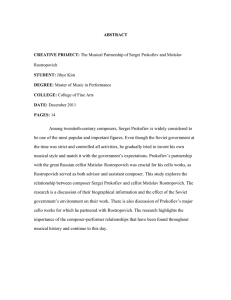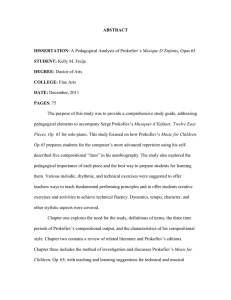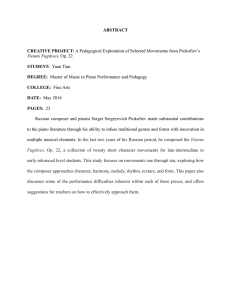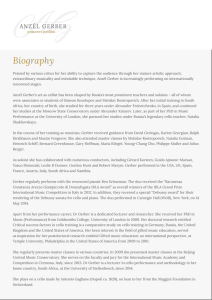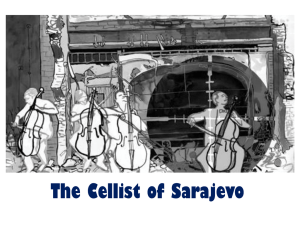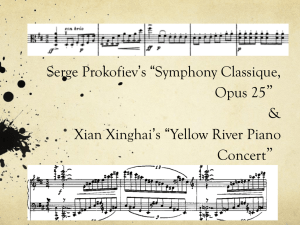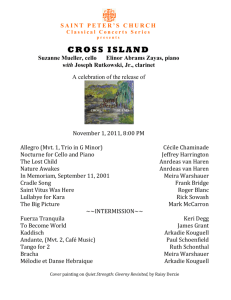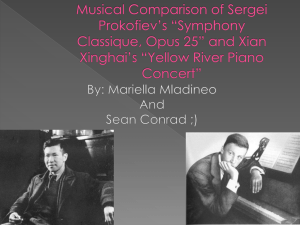THE MUSICAL PARTNERSHIP OF SERGEI PROKOFIEV AND MSTISLAV ROSTROPOVICH A CREATIVE PROJECT
advertisement
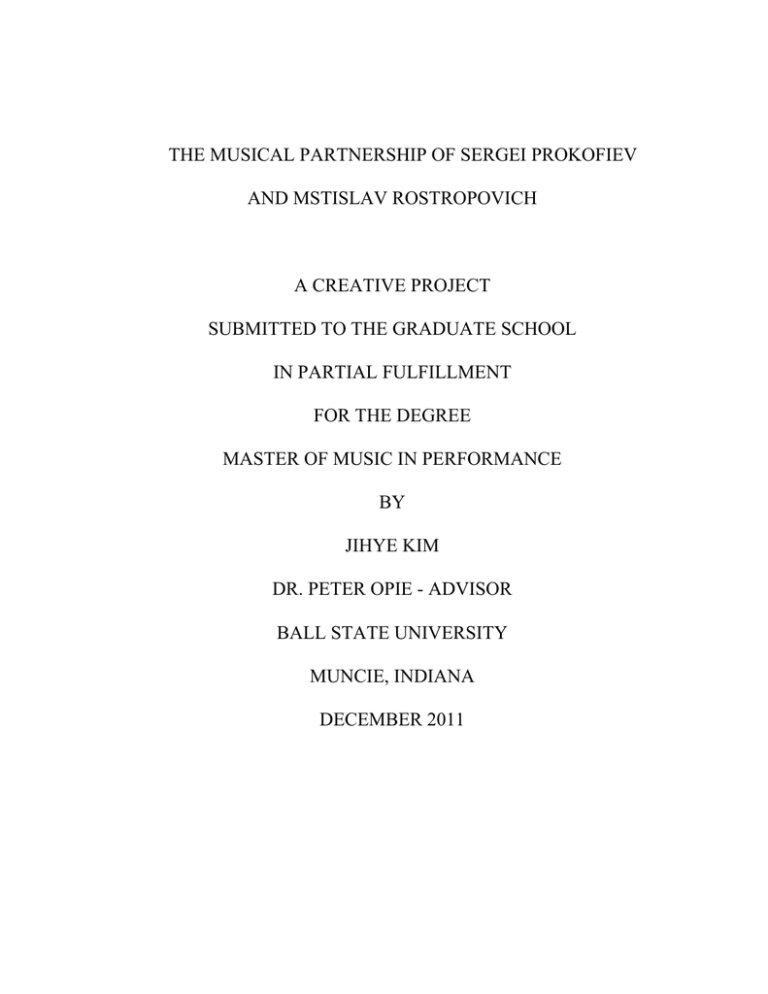
THE MUSICAL PARTNERSHIP OF SERGEI PROKOFIEV AND MSTISLAV ROSTROPOVICH A CREATIVE PROJECT SUBMITTED TO THE GRADUATE SCHOOL IN PARTIAL FULFILLMENT FOR THE DEGREE MASTER OF MUSIC IN PERFORMANCE BY JIHYE KIM DR. PETER OPIE - ADVISOR BALL STATE UNIVERSITY MUNCIE, INDIANA DECEMBER 2011 Among twentieth-century composers, Sergei Prokofiev is widely considered to be one of the most popular and important figures. He wrote in a variety of genres, including opera, ballet, symphonies, concertos, solo piano, and chamber music. In his cello works, of which three are the most important, his partnership with the great Russian cellist Mstislav Rostropovich was crucial. To understand their partnership, it is necessary to know their background information, including biographies, and to understand the political environment in which they lived. Sergei Prokofiev was born in Sontovka, (Ukraine) on April 23, 1891, and grew up in comfortable conditions. His father organized his general education in the natural sciences, and his mother gave him his early education in the arts. When he was four years old, his mother provided his first piano lessons and he began composition study as well. He studied theory, composition, instrumentation, and piano with Reinhold Glière, who was also a composer and pianist. Glière asked Prokofiev to compose short pieces made into the structure of a series.1 According to Glière’s suggestion, Prokofiev wrote a lot of short piano pieces, including five series each of 12 pieces (1902-1906). He also composed a symphony in G major for Glière. When he was twelve years old, he met Glazunov, who was a professor at the St. Petersburg Conservatory. On the recommendation of Glazunov, he took the entrance examination and passed (1904). He completed his studies at the conservatory in 1909 with unremarkable grades, but through the completion of this diploma, he accumulated his composition skills. A symphony in E minor, small-scale piano works, and six early sonatas were composed in this period.2 1 Dorothea Redepenning, “Prokofiev, Sergey,” in Grove Music Online. Accessed 22 August 2011, http://www.oxfordmusiconline.com/subscriber/article/grove/music/22402. 2 Redepenning, “Prokofiev, Sergey,” in Grove Music Online. 1 In his early life, he traveled to many European countries, such as France, England, Switzerland, and Italy. In 1919, he visited Rome and composed the Scythian Suite, op.20, which was inspired by Stravinsky’s The Rite of Spring. This piece was composed in the provocative style of the Russian literary futurists, and though it was an unfamiliar idiom to the audiences, it was attractive and successful. Based on these national characteristics, Russian music was introduced to the Western Europe.3 Prokofiev spent time from 1918 to 1922 in the United States. He had many performances throughout the USA, including in New York and Chicago. Even though performances of his First Piano Concerto and Scythian Suite were successful, he did not enjoy good financial circumstances, and when he did not receive support from the U.S. government, he decided to return to Europe (1922-1936), including France and Germany. In 1922, Prokofiev went to live in southern Germany and devoted his time to his opera The Fiery Angel. During his European period, he witnessed the premières of several of his compositions, such as Le Pas d’acier, The Prodigal Son, and On the Dnieper (all ballets). In these works, he again tried to include elements of the characteristics of Russian music.4 Even though he had built his reputation from his work in Western Europe, he returned to the Soviet Union in 1936 because of homesickness and his sense of patriotism. When he came back to the Soviet Union, he composed twelve easy piano pieces, three songs, and a symphonic fairytale for children, Peter and the Wolf. World War II further stimulated his patriotic feelings. At this time, he composed the opera War and Peace, based on Tolstoy’s novel. In his late years, he emphasized composing instrumental pieces, including Romeo and Juliet (1936), Cinderella (1944), and The Tale of the Stone Flower (1948-1950). Prokofiev 3 4 Redepenning, “Prokofiev, Sergey,” in Grove Music Online. Redepenning, “Prokofiev, Sergey,” in Grove Music Online. 2 passed away on March 5th, 1953 the exact same day as Joseph Stalin.5 Mstislav Rostropovich began his musical studies in early childhood with his parents; his mother was a pianist and his father, a cellist, had been a student of Pablo Casals. In 1943, Rostropovich entered the Moscow Conservatory to study the cello with Semyon Kozolupov and composition with Dmitri Shostakovich and Vissarion Shebalin. He also began to study conducting at the Moscow Conservatory.6 Later he travelled to Western countries, touring with concerto performances and recitals, making his British début in 1956, and his American début at Carnegie Hall, New York, in the same year.7 His record of giving outstanding performances motivated several composers to increase the repertoire of the cello throughout the twentieth century.8 He worked with, and become friends of, many these same individuals in both the Soviet Union and other European countries. His most celebrated partnerships were with Dmitri Shostakovich and Sergei Prokofiev from the Soviet Union, Benjamin Britten from Britain, Polish composer Witold Lutoslawski, and French composer Henri Dutilleux. They composed many pieces for Rostropovich, which he performanced widely and recorded.9 Until Rostropovich, the cello, as a solo instrument, did not enjoy anything like the profile or popularity of the violin or piano. Other Russian/Soviet composers that composed concertos or sonatas for Rostropovich include Reinhold Glière, Aram Khachaturian, and Nikolai Myaskovsky.10 5 Redepenning, “Prokofiev, Sergey,” in Grove Music Online. Noël Goodwin, “Rostropovich, Mstislav,” in Grove Music Online. Accessed 22 August 2011, http://www.oxfordmusiconline.com/subscriber/article/grove/music/23918. 7 Goodwin, “Rostropovich, Mstislav,” in Grove Music Online. 8 Tim Janof, “Conversation with Mstislav Rostropovich,” Internet Cello Society. Accessed 22 August, 2011, http://www.cello.org/newsletter/articles/rostropovich/rostropovich.htm. 9 Goodwin, “Rostropovich, Mstislav,” in Grove Music Online. 10 Goodwin, “Rostropovich, Mstislav,” in Grove Music Online. 6 3 Rostropovich was soloist in the first performance of Shostakovich’s two cello concertos in 1959 and 1966, Britten’s Cello Symphony in 1964, Arthur Bliss’ cello concerto in 1970, Henri Dutilleux’s cello concerto Tout un monde lointain in 1970 and Lutoslawski’s concerto. He was also regarded as an outstanding conductor, and he led many major orchestras, such as the National Symphony Orchestra of Washington, D.C., where he served as music director from 1977 to 1994, and the London Symphony Orchestra.11 His relationship with the London Symphony Orchestra was especially close, and he enjoyed many performances and made several recordings with them as both conductor and soloist. Several special festivals were organized with the orchestra, such as the Rostropovich 60th Birthday series (1987), Shostakovich: Music from the Flames (1988), and Festival of Britten (1993). He was widely regarded as one of the best interpreters of the music of Shostakovich, Britten, and Prokofiev.12 Always politically active, he also became known for his political gestures by playing unaccompanied Bach at the demolition of the Berlin Wall in 1989, supporting Boris Yeltsin at the Russian government building during the coup attempt of 1993, and playing with the English Chamber Orchestra at Buckingham Place for the 90th birthday of Queen Elizabeth, the Queen Mother, in 1990.13 In 1970, he famously protected the dissident Soviet author Alexander Solzhenitzyn by allowing him to live in his home, this led to his exile (in Paris, London, and New York) from his homeland from 1974 until the fall of communism and restoration of his Russian citizenship in 1990. Many of Rostropovich’s musical partnerships, including that with Prokofiev, came about during a time of great political stress in the Soviet Union, where the careers of all 11 Janof, “Conversation with Mstislav Rostropovich,” ; Elizabeth Wilson, Rostropovich: The musical life of the great cellist, teacher, and legend (Chicago: Ivan R. Dee, 2008), 315. 12 Tim Janof, “Conversation with Mstislav Rostropovich,” Internet Cello Society. 13 Goodwin, “Rostropovich, Mstislav,” in Grove Music Online. 4 artists came under the scrutiny of the Stalin regime. Many Russian composers, however, simply wanted to express and follow their own creative work, without political interference, so they left the country.14 Soviet music can be divided into three periods: (1) 1917-1927, when, essentially, Russian musicians tried to create new, innovative art; (2) 1927-1936, signaled by the appearance of, supposed, “proletarian” music; and (3) 1936-1950, when proletarian sectarianism and cosmopolitan modernism were abandoned in favor of Socialist Realism in Stalin’s phase.15 As in most countries, musical life in the Soviet Union continued throughout the Second World War. Some important symphonies were written during the war and emphasize the impression of an enormous struggle, including Prokofiev’s Symphony No.5 (the War symphony), Shostakovich’s Symphony No.7 (the Leningrad), and his No.8. After victory in the war, the Soviet people tried to restore their cultural life and re-established their cities following incalculable physical damage from the war.16 One of the most important composers in Soviet music was Sergei Prokofiev. Politically, his position is considered to have been strange.17After traveling in other countries, and having decided to return to the Soviet Union in 1936, he changed his musical style from atonal and experimental to tonal, probably in consideration of political demands. During the war, many of his works were influenced by the conflict including the First Violin Sonata Op.80 and the Second String Quartet Op.92. The government continually evaluated and 14 Boris Schwarz, “Soviet music since the Second World War,” The Musical Quarterly 51, no.1 (Jan. 1965): 259. 15 Nicolas Slonimsky, “The changing style of Soviet Music,” Journal of the American Musicological Society 3, no.3 (Autumn 1950): 236. 16 Schwarz, 259. 17 Slonimsky, 242. 5 criticized Prokofiev’s work, in a similar fashion to their attacks on other musicians.18 Prokofiev tried to change his musical style to match the Russian government’s expectation by applying simplicity, clarity, lyricism, and folk tunes.19 He wrote four operas between 1939 and 1948, including War and Peace (1941-1951) based on the epic novel, Duenna (1940-1946) based on the comic, Semyon Kotko (1939-1940), and The Story of a Real Man (1947-1948) the latter two works based on Soviet topics.20 He wanted his works to be available and allowed in Soviet culture, so he tried to follow the many policies that the government promulgated. During this time, most composers’ works had to be approved by the Union of Soviet Composers, which was established in accordance with a 1932 Resolution.21 For example, in his opera, The Story of a Real Man (1948), he made great efforts for his work to be approved. Firstly, to make it the most simple and accessible of his operas, the work uses numerous folk tunes (in fact, using many folk tunes directly). Secondly, the main character, Aleksei, can be considered as an archetypal Soviet hero. Prokofiev serves as a great example of the situation that affected artists’ lives and careers in the Soviet Union during and after the Second World War.22 Swiss composer Arthur Honegger wrote that Prokofiev’s achievements were one of the greatest in contemporary music. He also said that Prokofiev effectively lead the Soviet musical scene from 1936 (the year he returned to Moscow after abroad) to 1953.23 In the post-war period, Prokofiev wrote the Sixth and Seventh Symphonies. However, some criticized the Sixth Symphony by stating that Prokofiev had returned to his 18 Won-hee An, “Three cello sonatas after World War Two: Poulenc, Prokofiev, Carter” (Ph.D. diss, Boston University, 2007), p.14. 19 An, “Three cello sonatas after World War Two: Poulenc, Prokofiev, Carter,” 131. 20 Schwarz, 262-263. 21 Redepenning, “Prokofiev, Sergey,” in Grove Music Online. 22 An, “Three cello sonatas after World War Two: Poulenc, Prokofiev, Carter,” 26-27. 23 Schwarz, 262. 6 old Expressionistic tendencies again. This symphony was, accordingly, not performed after its première. Soviet critics analyzed the symphony, and their strong criticisms included derision of the work’s "outbursts of unrestrained expressionism, utterly incomprehensible to the listener."24 In Prokofiev’s cello works, his partnership with Mstislav Rostropovich was crucial. Rostropovich studied compositional techniques with his father’s friend, Reinhold Glière, who had been Prokofiev’s teacher as well. Glière was impressed by both the cello and composition talents of Rostropovich. So, Glière wrote a cello concerto that became the first work ever dedicated to Rostropovich.25 Nikolay Myaskovsky and Prokofiev were very close friends from their student years, and kept their relationship. Prokofiev thought that if Glière had been one of the most distinguished Soviet composers, Myaskovsky was to be one of the most admired of the next generation. In Rostropovich’s own view, his career was transformed by performing Myaskovsky’s new music. He later said that, “The Myaskovsky concerto was the beginning of a definite path in life for me. Myaskovsky led me to Prokofiev, and Prokofiev indirectly to Shostakovich, and through Shostakovich to Britten.”26 Among Rostropovich’s other composition teachers was Prokofiev himself. Elizabeth Wilson describes Rostropovich’s account of being presented to Prokofiev: Of course he took next to no notice of me, since I was a boy as far as he was concerned. But after December 1945, when I won the All-Union competition, he started to remember who I was. This was no doubt because I had played the concerto of his great friend Myaskovsky. I then decided to learn his first cello concerto and play it with piano at my solo recital in the Small Hall of the Conservatory.27 Moreover, Rostropovich later recalled that, when Prokofiev was brought by Miaskovsky to 24 25 26 27 Schwarz, 271-272. Wilson, 64. Wilson, 65. Wilson, 66. 7 his recital in 1949 to hear the premier of Miaskovsky’s cello sonata, Prokofiev said to him, "I shall now start writing a cello sonata for you."28 Thus Prokofiev composed his Sonata for piano and cello op.119 for Rostropovich in 1949. In the sonata, Prokofiev showed a combination of traditional and non-traditional ways of writing, in various aspects of the work. The traditional characteristics include the use of cyclical form, simple rhythms, and tonality. In an example of cyclical form, he used the primary theme from the first movement from measure 199 of the last movement until the end of the work. But, the theme appears more powerfully than in the first movement, this time with the piano playing octaves for both hands (see examples 1 and 2). The sonata also consists of three movements in the traditional forms of sonata-allegro, minuet-trio, and rondo.29 Example 1: Sergei Prokofiev, Sonata for piano and cello op.119, 1st mov, mm.1-5. 28 29 Janof, “Conversation with Mstislav Rostropovich,” Internet Cello Society. An, “Three cello sonatas after World War Two: Poulenc, Prokofiev, Carter,” 71; 131-132. 8 Example 2: Sergei Prokofiev, Sonata for piano and cello op.119, 3rd mov, mm.199-201. In his late period, while he tried to follow the Soviet government’s systems strictly, he also made great efforts to keep to his own style.30 After composing the sonata, Prokofiev also wrote the Symphony-Concerto, op.125 for cello and orchestra (1950-1952), and begun work on the unfinished Concertino for cello and orchestra op.133, and Sonata for solo cello op.134 (1952). These pieces were all inspired by Rostropovich. The Symphony-Concerto was actually a later version of a Concerto for Cello and Orchestra op.58 that Rostropovich had greatly helped Prokofiev revise. Rostropovich gave the first performance, with Sviatoslav Richter conducting (in what is believed to be the only public performance Richter ever gave as a conductor).31 Prokofiev, however, never heard this piece played with orchestra. During this time, Soviet composers were affected by each other’s compositions. Even though their preferences in music were very different, they respected each other. They also listened to each other’s music and got ideas from each other’s works. For example, 30 An, “Three cello sonatas after World War Two: Poulenc, Prokofiev, Carter,” 71. Redepenning, “Prokofiev, Sergey,” in Grove Music Online ; Simon Morrison, Sergey Prokofiev and his world (Princeton: Princeton University Press, 2008), 264 ; Wilson, 71. 31 9 Prokofiev’s Symphony-Concerto later affected Shostakovich’s works. Shostakovich liked the combination of cello and celesta in Symphony-Concerto, and thus this instrumentation was later used in Shostakovich’s next cello work, his first cello concerto. He also liked the dramatic beat of the timpani after passages of running high notes in the solo cello in the Symphony-Concerto, so he used this idea in another piece as well. Shostakovich thought that the Symphony-Concerto was the most brilliant work among all of Prokofiev’s works.32 In another example, when Prokofiev had heard the Miaskovsky sonata with Rostropovich and Richter, he found that he could not hear any of the difficult fast notes in the cello’s lower register because the piano, despite Richter’s sensitivity, covered them. Thus, when Prokofiev composed fast, low notes in the cello part at the beginning of the second movement of Symphony-Concerto, he organized the orchestration so that the notes can be heard clearly (see example 3).33 32 33 Janof, “Conversation with Mstislav Rostropovich,” Internet Cello Society. Janof, “Conversation with Mstislav Rostropovich,” Internet Cello Society. 10 Example 3: Sergei Prokofiev, Symphony-Concerto Op.125, 2nd mov, mm. 1-11. Throughout the composition of his major cello works, Prokofiev frequently consulted with Rostropovich for his expertise on all matters of the instrument. For example, while the première of the Cello Concerto Op.58 had not been particularly successful, Prokofiev still felt the work had some good material. So, after hearing Rostropovich perform it in 1947, he 11 asked him about assisting him in revising the piece.34 The result was the Symphony-Concerto. At one stage, Prokofiev wanted to write eight bars of great virtuosity for the soloist in the first movement, so, he requested that Rostropovich write this section himself and put it in the first movement of Symphony-Concerto (See example 4). Example 4: Sergei Prokofiev, Symphony-Concerto Op.125, 1st mov, from number 20 to after 8 measures. 34 Janof, “Conversation with Mstislav Rostropovich,” Internet Cello Society. 12 Prokofiev also began work on the Concertino for Cello and Orchestra, again in collaboration with Rostropovich.35 He finished only the slow movement of the Concertino in the cello and piano version before his death, and instead, Rostropovich completed the work himself, alongside Dmitri Kabalevsky, who orchestrated it. Rostropovich also premiered this work in 1956.36 The Sonata for solo cello op.132 is the very last piece that Prokofiev began in the latter half of 1952, and, like the concertino, he did not finish it. He completed sketches for the first movement only. Unlike the other cello works, the single movement was completed by Vladimir Blok, and performed for the first time by Natalia Gutman in Moscow in 1972. Even though the government was strict and controlled all activities, Prokofiev gradually tried to invent his own musical style and match it with the Soviet government’s expectations. Prokofiev’s partnership with the great Russian cellist Mstislav Rostropovich was crucial for his cello works, as both inspiration, “cellistic” advisor, and, at times, assistant composer. It is a major addition to the list of important composer-performer relationships that have been found throughout musical history and continue to this day. 35 36 Claude Samuel, Prokofiev (London: Calder & Boyars, 1971), 154. Wilson, 125-126. 13 Bibliography An, Won-hee. “ Three cello sonatas after World War Two: Poulenc, Prokofiev, Carter.” Ph.D. diss., Boston University, 2007. Goodwin, Noël. “Rostropovich, Mstislav.” In Grove Music Online. Accessed 22 August 2011. < http://www.oxfordmusiconline.com/subscriber/article/grove/music/23918> Janof, Tim. “Conversation with Mstislav Rostropovich.” Internet Cello Society. Accessed 22 August, 2011. <http://www.cello.org/newsletter/articles/rostropovich/rostropovich.htm> Morrison, Simon. Sergey Prokofiev and his world. Princeton: Princeton University Press, 2008. Redepenning, Dorothea. “Prokofiev, Sergey.” In Grove Music Online. Accessed 22 August 2011. <http://www.oxfordmusiconline.com/subscriber/article/grove/music/22402> Samuel, Claude. Prokofiev. London: Calder & Boyars, 1971. Schwarz, Boris. “Soviet music since the Second World War.” The Musical Quarterly 51, no.1 (Jan. 1965): 259-281. Slonimsky, Nicolas. “The changing style of Soviet Music.” Journal of the American Musicological Society 3, no.3 (Autumn 1950): 236-255. Wilson, Elizabeth. Rostropovich: The musical life of the great cellist, teacher, and legend. Chicago: Ivan R. Dee, 2008. 14
